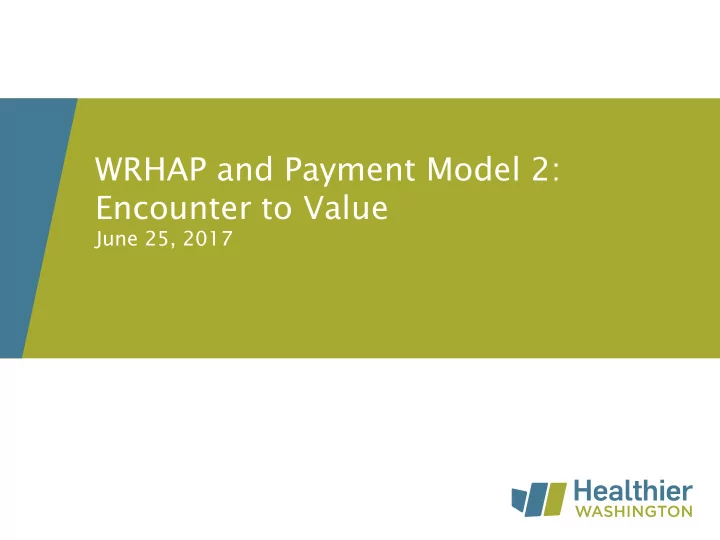

WRHAP and Payment Model 2: Encounter to Value June 25, 2017
Goals and Evolving Strategy for Payment Reform 2
Goals of WRHAP Payment Reforms • Design and implement improvements in payment and delivery for health care in Washington’s smallest and remote communities, where CAHs are at risk of closing. • Identify patient-centered approaches that improve the quality of care for clients 3
Why is VBP a core business strategy of HCA? • Current FFS system is unsustainable and broken • Market leverage as largest purchaser in WA • Payment drive delivery system transformation • Value-based purchasing legislative mandate • National movement • Early results are promising 4
HCA and Medicare’s VBP goals 2021 90% state-financed 50% commercial In 2016, at least 30% 30% of 2016 2021 In 2021, at least 90% 90% of state- Medicare payments are 30% financed health care payments 90% linked to quality and and 50% 50% of commercial health value through APMs 50% care payments are linked to quality and value through APMs In 2018, at least 50% 50% of (Categories 2c-4b) 2018 Medicare payments are 50% linked to quality and value through APMs 5
Alignment with CMS’ Alternative Payment Models Framework 6
HCA Value-based Roadmap • Reward patient-centered, high quality care • Reward health plan and system performance • Align payment and reforms with CMS • Improve outcomes • Drive standardization 2021: • Increase sustainability of state health programs 90% • Achieve Triple Aim VBP 2019: 80% VBP Medicaid PEBB 2016: 20% 7 VBP
CMMI Guidance Patient-centered • – Improvement on quality and patient experience Accountable for total cost of care • – Commitment to managing the total cost of care Transformative • – Changes in the way that care is delivered from a multi-payer perspective Broad-based • – Broad provider and payer participation Feasible to implement • – Assurances that model is administratively feasible Feasible to Evaluate • – Performance against a baseline 8
Authorizing Environment Guidance • Promotion of ‘quality, efficiency, cost savings, and health improvement, for Medicaid’ – Budget neutrality of the model • Demonstration through analysis that the model will not cost the state more in total appropriations – Alignment with value-based purchasing • Reward for the delivery of high quality care through implementing new payment models 9
HCA Goals and Intents • Alignment with the desires expressed by CMMI and our authorizing environment • Alignment with national trends and current HCA directionality • Recognize the challenges faced by providers and identify a workable model that helps to build long-term sustainability and move toward value-based purchasing 10
Basic Parameters of the Model Minimum services included to start: • Inpatient, Observation, Swing-bed, ED, Outpatient, Ancillary – Basic construct: • All-payer – Scalable to additional providers – Same basic structure for all participating providers with flexibility in – performance and redesign efforts Payment is linked to historical revenue, utilization, and/or costs in a – budget neutral approach Per-Resident payment: – • The budget is set to a per-resident amount for attributed members for each participating payer 11
Tracking the Shift in Process Comparative WRHAP Proposal Under HCA Desired Approach Element Discussion Scope of services Leads with Leads with included at start • ED • Inpatient • Primary care • Observation • LTC • Swing-bed ED • • Outpatient • Ancillary Phasing Over time, expands to include: Over time, expands to include: Inpatient and outpatient Primary care • • • other services • LTC • other service Defining the Based on minimum requirements Based on historical revenues, Budget to sustain services according to utilization and/or costs agreed upon standards 12
Tracking the Shift in Process Comparative WRHAP Proposal Under HCA Desired Approach Element Discussion Key Payment Options proposed include starting • Hospitals would receive a constructs with: predefined amount for the • ED scope of services included • Per-visit and per-resident payments with quality and Per-resident payment or • utilization adjustments budget for attributed • Primary care members • Per-resident for clinic services • Clients not attributed would Payment for enhanced be reimbursed under current • services system • Quality bonus • Increased or minimum • Retrospective reconciliation of payment to LTC billings current payment under current budget 13
Designing the Payment Model Timeline 14
CMMI Timeline and Commitments Commitments to CMMI • – Development and delivery of a ‘term sheet’ to CMMI – Agreement in principle to explore this model with CMMI CMMI STCs • – 7/31/2017 • Implementation discussions held with stakeholders – 1/31/2018 • Agreement in principle with CMS on final model, including identification of required CMS authority and necessary timeline/process 15
Upcoming Activities • Additional model review and iteration • Target a working session for rapid turnaround • Engagement of payers • Draft a term sheet • Draft letter of intent 16
Recommend
More recommend